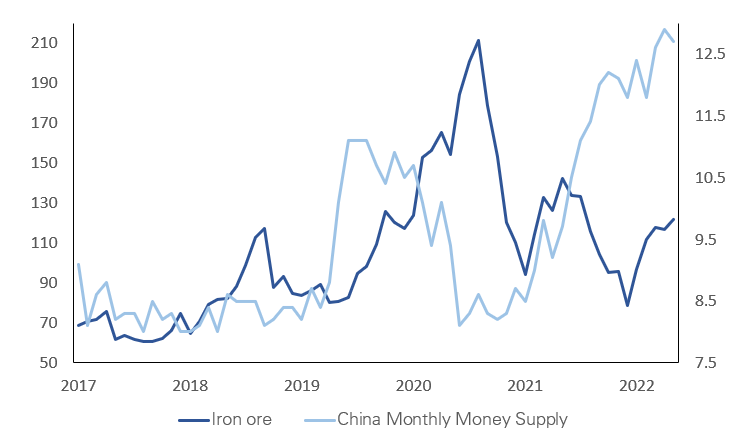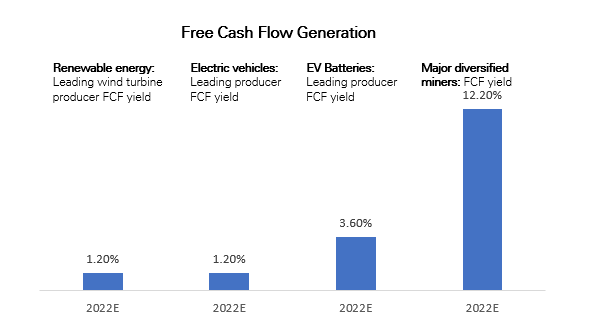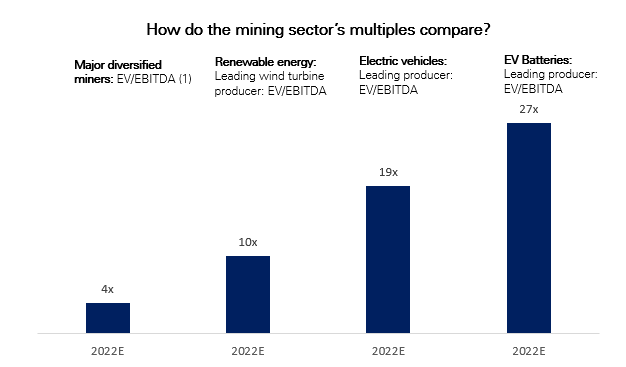5 prevailing tailwinds supporting commodities
1. Emerging Market strength
Emerging Market strength in commodity demand from China, India, the Middle East, Africa and Latin America (74% Copper demand) sharply outweighs current and forecast weakness in the US & EU (26% of total Copper demand).
Despite being patchy in nature, we have seen signs of growth from China as their economy emerges from lockdowns and people get back out, travel and spend. At the end of March, the People’s Bank of China (PBoC) cut the reserve requirement ratio by 25 bp providing yet another string in the bow of support that has emerged for the Chinese economy since the end of last year. This also offers a glimpse into the mindset of authorities as they continue to support the economy without fear of inflation, which is currently at 0.10%.
The Chinese Purchasers Manager Index (PMI), an index of the economic strength in manufacturing and services, was released in early April of 57.8 vs. 55.0 in Feb, making it the strongest PMI growth since Nov 2020. We’ve also seen Chinese money supply increasing nicely which is one of the most reliable leading indicators of commodity price performance, usually leading physical commodity demand by around 3-6 months (Chart 1). While there has been some flow through into commodities such as iron ore and copper, we would expect the majority of the impact to start being felt in the second half of 2023.
We appreciate that recent data and commentary from China has been negative but overall remain confident of a recovery in the medium to long term and are taking advantage of the recent volatility.
Chart 1: Chinese money supply (RHS) vs the 62% Iron Ore price

Anecdotal data out of China continues to suggest that the Chinese consumer is beginning to spend their savings, just as every other person did globally after they had been locked down. Macau’s gross revenues are up 250% YoY, bullish comments have come out from LVMH, Hermes and the Accor Hotels Group CEO who suggested hotels in Shanghai were booming, which matches the data showing a sharp increase in airline passengers.
In early April, China announced that two thirds of its provinces are planning major construction with a total spend of US$1.8 trillion, representing an increase of 17% on last year. The spending will largely be on major projects such as transport infrastructure, energy generation and industrial parks which is contrary to the popular view that the infrastructure spending in China is negligible.
2. Energy transition
Over the 2000’s China spent circa US$10 Trillion on infrastructure, or in real terms about US$15 Trillion. The global, green investment initiative (electrification, etc.) for the next 10 years is forecasted to be US$56 Trillion (Goldman Sachs estimates). It is a massive level of investment, but this time the whole world is contributing, not just China, rebuilding energy infrastructure.
The energy transition has begun to generate significant demand growth in some commodities which we think is broadly underappreciated by the market, especially considering that green demand is now dominating the growth of many industrial metals and adds a non-cyclical demand story to traditionally cyclical markets.
This consumer driven push for electric vehicles and renewable power sources in China, Europe and the US is being complimented by government policies which continue to escalate industrial competition between east and west.
China remains the leader in terms of solar installations and EV uptake in the short term, accounting for >50% of green metals demand but the RePowerEU and Inflation Reduction Act (IRA) are placing green technology and infrastructure at the core of a reindustrialisation of the West over the coming decade.
The IRA and RePowerEU capital is non-traditional, in so far as its not being deployed for strictly commercial purposes. In fact, we would argue the main divers are geopolitical security of supply and environmental concerns. As such, when we look at the return on equity of prospective mining development projects, they can have a significant positive impact.
3. Commodity Fundamentals
The uptick in demand is now colliding with a period of chronically low supply, both from mine production and physical stockpiles. Using copper as an example; stockpiles are down 13% and are depleting from lower levels than previous years leading to a significant risk of a price spike in the short term.
4. Cost Inflation and CAPEX
The mining sector is not immune to inflation which has seen the costs of metal production increase significantly over the past few years. Rising input costs and labour shortages have meant that costs of production have escalated to the point that downside to current spot prices in many commodities is extremely limited. Using copper as the example again, the top end of the copper mining cost curve is now around $8,500/t, only 3.5% below the current spot price.
It is staggering to note that in the current pricing environment we are just a year away from peak copper mine supply and there has been virtually no shift in the appetite from the mining sector towards growth. The world’s major miners are still focused on capital returns have expressed little appetite to build new sources of metals supply, despite widely touting the need for more copper.
There has been an uptick in M&A and we suspect we are the beginning of what will be a busy couple of years for mining bankers as it remains a lot cheaper for major miners to buy mining companies that it is to find deposits and develop them.
5. Mining sector valuations
Given the relative outperformance of mining sector equities we are often asked if the sector is still well priced, especially considering there are alternative methods to play the energy transition. Completely discounting the fact that the commodities we are most heavily exposed to have significant upside price risk, we can safely say the sector remains cheap.
Using the major miners as an example, debt levels remain low and free cash flow generation is exceptionally high while the sector continues to trade on undemanding EV/EBITDA multiples.

How do the mining sector’s multiples compare?

Source: Glencore, Citi, Factset
(Note: Includes Anglo American, BHP, Vale, Glencore and Rio Tinto.)
Top commodities and stock ideas for the next 12-24 months
Copper – the poster child commodity of energy transition: Our key exposures are in Canadian (TSX) companies but on the ASX we think Metals Acquisition Corp (NYSE: MTAL) that should dual list in Australia in 2H 23 will be one to watch. They are proposing to buy the CSA mine from Glencore.
Uranium – prices to move up as we enter a contracting cycle. Again, the Fund’s key holdings are Canadian listed but we also like Nexgen Energy (ASX: NXG)
Gold – The highest quarterly closing price ever was recorded recently, we think all equity holders should have exposure to gold and we like Emerald Resources (ASX: EMR)
5 topics
4 stocks mentioned

